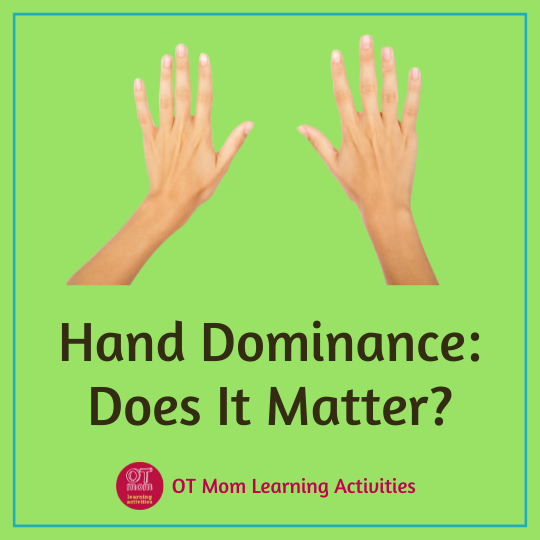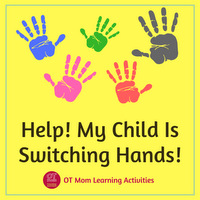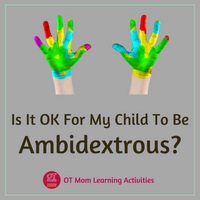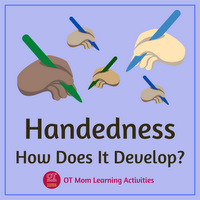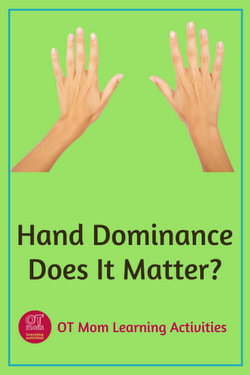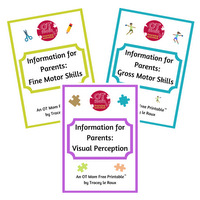- Home Page
- Hand Dominance
Hand Dominance
Hand dominance and hand preference are terms that refer to a person’s consistent choice of one hand rather than the other hand for a skilled task.
I sometimes link to products (#Ad) that are similar to those I use and love. If you do purchase something through my links, I will receive a small commission that helps support my site - thank you!
Why Is It Important That My Child Has A Dominant Hand?
The human brain is divided into two (left and right) cerebral hemispheres that are specialized to perform different tasks (such as language and spatial reasoning*), and yet also work together when both sides are needed to produce the best results in physical and mental tasks.
Both hemispheres have an area called the motor cortex. When it comes to moving the body, the left motor cortex controls movements on the right side of the body, and the right motor cortex controls movements on the left side of the body.
Being able to use a tool with the same hand consistently and in a precise way (such as drawing with a pencil, using a screwdriver, cutting with scissors) can be an indication that the hemispheres of the brain have become specialized, or lateralized, for a specific function, which shows in the specialization, or dominance, of one hand for a particular task.
Children who don’t have a strongly specialized left or right hand for a specific task, who switch hands when a specialized hand is required, may struggle to carry out fine motor tasks that require automatic, learned movements, such as cutting neatly on a line with scissors, or writing with a pencil.
The more a child uses a specific hand for a task, the more efficient the child becomes at that task, and then the movement becomes “automated”, which frees the brain up for other cognitive tasks.
Basically, that means that when your child can easily control a pencil with a consistently preferred hand, your child will be more able to write efficiently and effectively, and to pay more attention to thinking about what to write. Hand dominance matters!
What About The Other Hand?
The "non-dominant" hand has a very important role to play!
When the non-dominant hand moves in a coordinated way, the dominant hand is enabled to be far more accurate and more efficient during precision tasks.
Think about how the “other hand” holds and moves the paper during an intricate scissor cutting task as shown here.
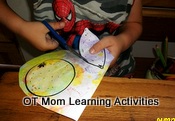 The non-dominant hand plays an important role.
The non-dominant hand plays an important role.Or consider how the non-dominant hand holds a woodwork item with just the right degree of stability and at just the right angle while the “dominant hand” uses the tool. The non-dominant hand also works to stabilize the paper during handwriting, and to stabilize the ruler when drawing a line.
Essentially, both hands are working together, but one hand is specializing in precise tool use, and the other is specializing in assisting. The movements made by the assistant hand can actually be quite demanding and require good control, and they should not be regarded as unimportant.
What If My Child Does Not Yet Have A Dominant Hand?
There are differing views on when hand dominance is established, but many experts agree that a consistent hand preference begins to emerge between ages 2 and 4 years, and that most children entering Kindergarten (age 5-6) have established a definite hand preference for using a pencil and scissors.
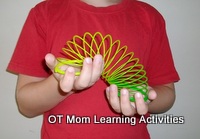
If your child is about to enter formal schooling (age 5-6) and has not yet developed a specialized hand for using a pencil and cutting with scissors, then I really recommend that you take your child to an occupational therapist, who can assess your child and help take the necessary steps as soon as possible.
Your child needs as much help as possible to help writing to become “automated” to enable learning to be fun and as stress-free as possible.
Pages Related To Hand Dominance
Hand Dominance References & Resources
- Collmer, Katherine. Handwriting and the Non-Dominant Hand. 5 January 2016. (Retrieved 14 January 2016)
- Davidson, T.;Tremblay, F. (2013). Hemispheric Differences in Corticospinal Excitability and in Transcallosal Inhibition in Relation to Degree of Handedness. PLoS ONE 8(7): e70286. http://journals.plos.org/plosone/article?id=10.1371/journal.pone.0070286
- Mastin, Luke. Handedness and the Brain. (Retrieved 27 February 27 2017)
- Vlachos, Filippos; Gaillard, Francois; Vaitsis, Kiriazis, and Argiris Karapetsas (2013). Developmental Risk: Evidence from Large Nonright-Handed Samples. Child Development Research Volume 2013 Article ID 169509. http://dx.doi.org/10.1155/2013/169509
- Zago, L., et al. (2015) The association between hemispheric specialization for language production and for spatial attention depends on left-hand preference strength. Neuropsychologia (2015). http://dx.doi.org/10.1016/j.neuropsychologia.2015.11.018
* Footnote: For example, in most people, the left hemisphere of the brain is specialized for language, while the right hemisphere is more specialized in visual-spatial skills.
Thank you for visiting my site! I hope you found this page helpful! Why not sign up for my newsletter to stay in touch with new pages and new activities as they are released?
- Home Page
- Hand Dominance
Share this page to help others!
Didn't find what you were looking for? Try a search of my site!
